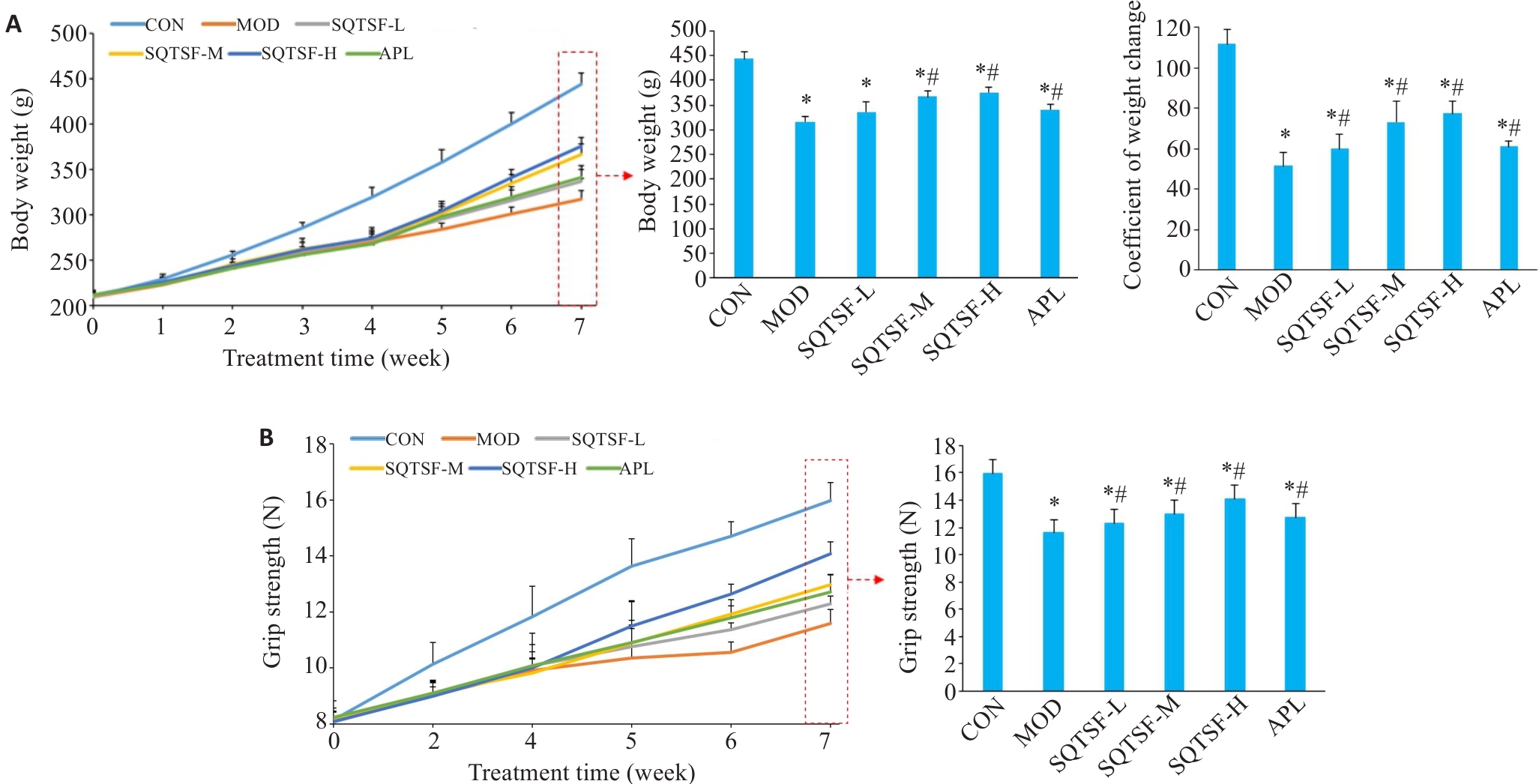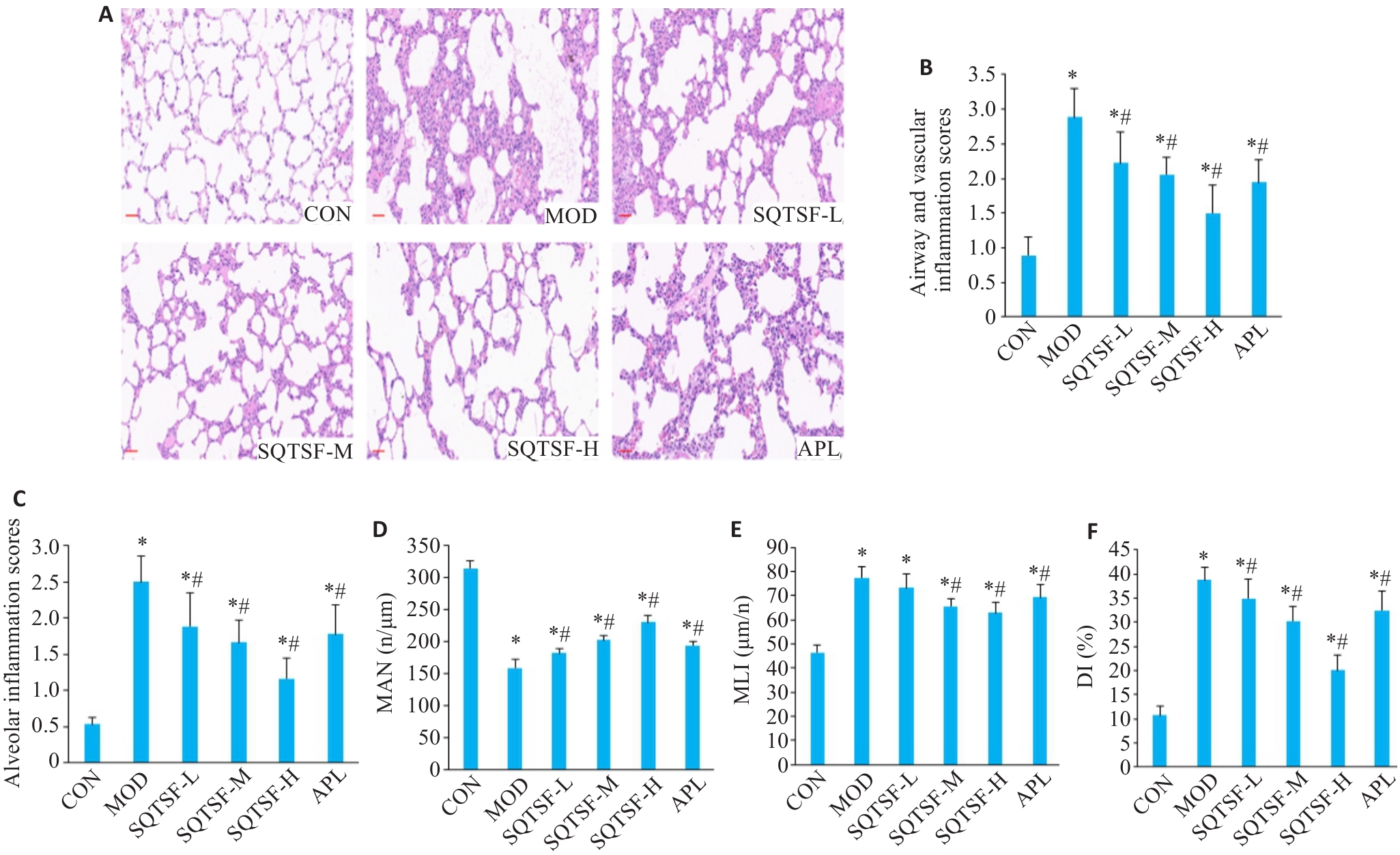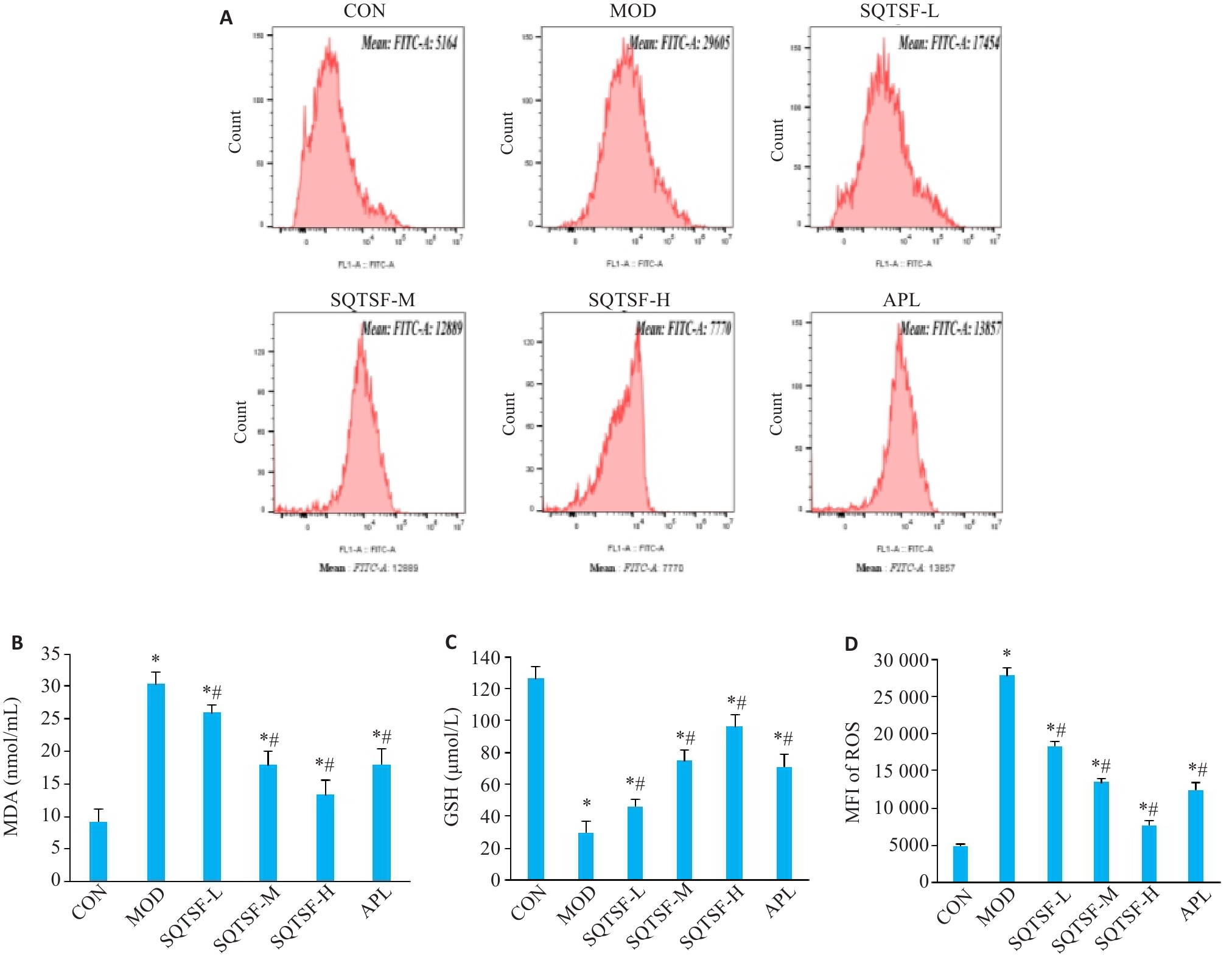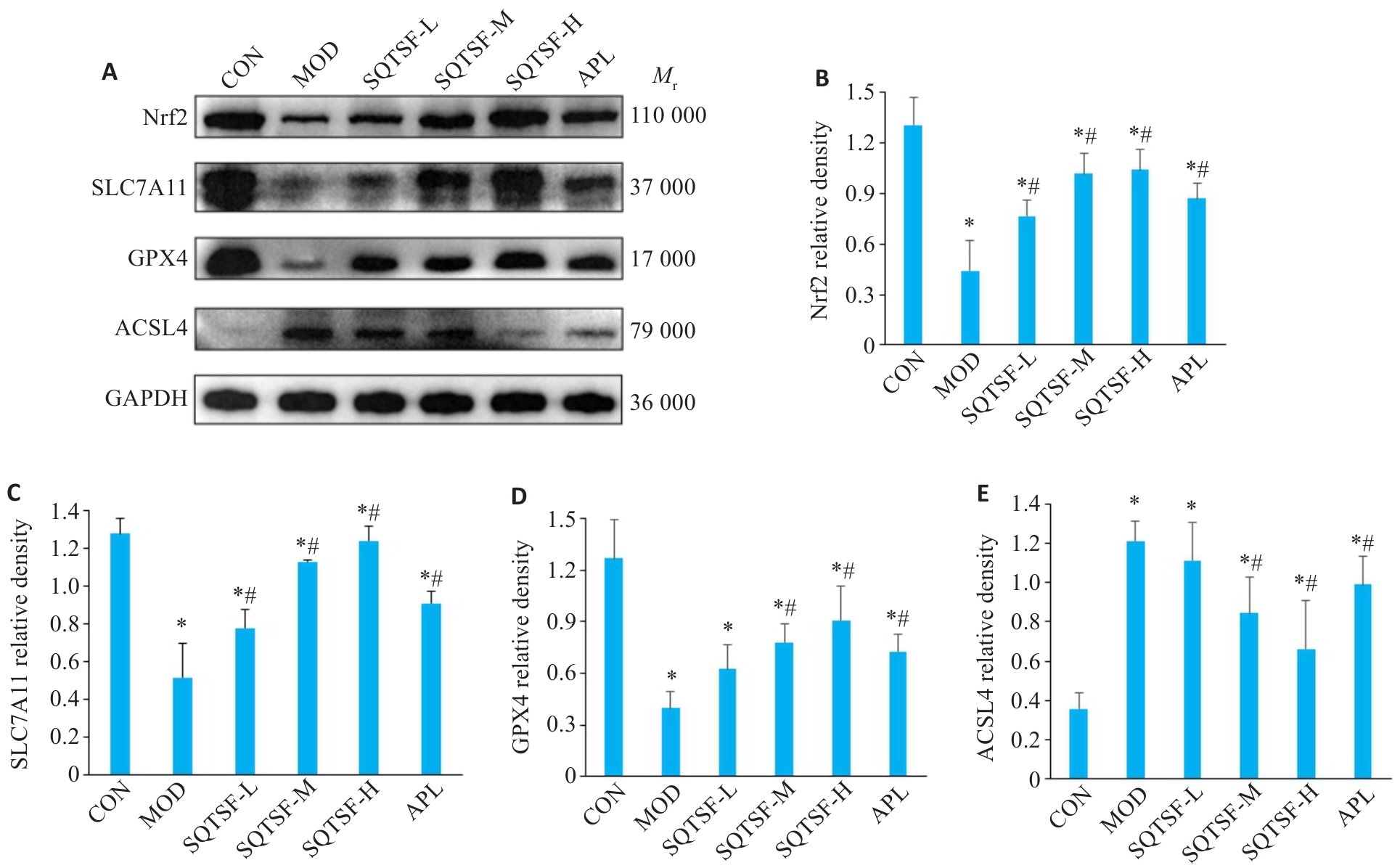Journal of Southern Medical University ›› 2024, Vol. 44 ›› Issue (10): 1937-1946.doi: 10.12122/j.issn.1673-4254.2024.10.12
Previous Articles Next Articles
Qinjun YANG1,2,3( ), Hui WANG1, Shuyu XU1, Cheng YANG4, Huanzhang DING1, Di WU1, Jie ZHU1, Jiabing TONG1,2, Zegeng LI2,3,4(
), Hui WANG1, Shuyu XU1, Cheng YANG4, Huanzhang DING1, Di WU1, Jie ZHU1, Jiabing TONG1,2, Zegeng LI2,3,4( )
)
Received:2024-09-02
Online:2024-10-20
Published:2024-10-31
Contact:
Zegeng LI
E-mail:yangqjahtcm@163.com;li6609@126.com
Supported by:Qinjun YANG, Hui WANG, Shuyu XU, Cheng YANG, Huanzhang DING, Di WU, Jie ZHU, Jiabing TONG, Zegeng LI. Shenqi Tiaoshen Formula alleviates airway inflammation in rats with chronic obstructive pulmonary disease and kidney qi deficiency syndrome by inhibiting ferroptosis via regulating the Nrf2/SLC7A11/GPX4 signaling pathway[J]. Journal of Southern Medical University, 2024, 44(10): 1937-1946.
Add to citation manager EndNote|Ris|BibTeX
URL: https://www.j-smu.com/EN/10.12122/j.issn.1673-4254.2024.10.12

Fig.2 Comparison of body mass, body mass coefficient (A) and grip strength (B) of the rats among the groups. *P<0.05 vs control group, #P<0.05 vs model group.

Fig.3 Comparison of pulmonary function indexes among the groups. A: FEV0.1. B: FVC. C: FEV0.1/FVC. D: Cdyn. *P<0.05 vs control group, #P<0.05 vs model group.

Fig.4 Comparison of lung histopathological morphology and lung histopathological scores among the groups (n=6, Mean±SD). A: HE staining of rat lung tissue (scale bar=40 μm). B: Airway and vascular inflammation score. C: Alveolar inflammation score. D: MAN. E: MLI. F: DI. *P<0.05 vs control group, #P<0.05 vs model group.

Fig.5 Comparison of BALF inflammatory factors among the groups. A: IL-1β. B: TNF-α. C: IL-6. D: IL-13. *P<0.05 vs control group, #P<0.05 vs model group.

Fig.6 Comparison of oxidative stress indexes in lung tissues among the groups. A: Flow cytometry for detecting ROS in the lung tissue. B: MDA. C: GSH. D: MFI of ROS. *P<0.05 vs control group, #P<0.05 vs model group.

Fig.9 Expression of ferroptosis-related proteins in each group. A: Western blotting for detecting expressions of Nrf2, SLC7A11, GPX4, and ACSL4 in the lung tissue. B-E: Relative protein expression levels of Nrf2, SLC7A11, GPX4 and ACSL4. *P<0.05 vs control group, #P<0.05 vs model group.
| 1 | 中华医学会呼吸病学分会慢性阻塞性肺疾病学组, 中国医师协会呼吸医师分会慢性阻塞性肺疾病工作委员会. 慢性阻塞性肺疾病诊治指南(2021年修订版)[J]. 中华结核和呼吸杂志, 2021, 44(3): 170-205. DOI: 10.3760/cma.j.cn112147-20210109-00031 |
| 2 | Wang C, Xu JY, Yang L, et al. Prevalence and risk factors of chronic obstructive pulmonary disease in China (the China Pulmonary Health[CPH]study): a national cross-sectional study[J]. Lancet, 2018, 391(10131): 1706-17. |
| 3 | Qin HY, Li MD, Xie GF, et al. Associations among S100A4, sphingosine-1-phosphate, and pulmonary function in patients with chronic obstructive pulmonary disease[J]. Oxid Med Cell Longev, 2022, 2022: 6041471. |
| 4 | Yoshida M, Minagawa S, Araya J, et al. Involvement of cigarette smoke-induced epithelial cell ferroptosis in COPD pathogenesis[J]. Nat Commun, 2019, 10(1): 3145. |
| 5 | Xu Y, Li YT, Li JX, et al. Ethyl carbamate triggers ferroptosis in liver through inhibiting GSH synthesis and suppressing Nrf2 activation[J]. Redox Biol, 2022, 53: 102349. |
| 6 | 杨勤军, 童佳兵, 王传博, 等. 基于肺气虚证四级分度理论探讨“以证统病”的肺病管理模式[J].中华中医药杂志, 2022, 37(9): 5467-70. |
| 7 | 李建生, 余学庆. 慢性阻塞性肺疾病中医分期分级防治策略[J]. 中医杂志, 2019, 60(22): 1895-9. |
| 8 | 王成阳, 李泽庚.六味补气胶囊对COPD肺气虚证大鼠JAK/STAT通路、MMPs/TIMP的影响[J].中华中医药杂志, 2014, 29(5): 1384-90. |
| 9 | 张 伟, 张心月, 邵雨萌. 中医药对各型慢性阻塞性肺疾病大鼠核因子κB和γ-谷氨酰半胱氨酸合酶表达的影响[J]. 中国中西医结合杂志, 2007, 27(5): 426-30. |
| 10 | 杨勤军.补肺益肾法治疗COPD稳定期系统评价及参芪调肾方调控巨噬细胞极化改善气道炎症机制研究[D].安徽中医药大学, 2023. |
| 11 | 陈进成, 刘建勋, 林成仁, 等. 基于“劳则气耗” 理论研究气虚证动物模型的建立方法[J]. 中国中药杂志, 2018, 43(11): 2177-83. |
| 12 | Wang H, Sorenson EJ, Spinner RJ, et al. Electrophysiologic findings and grip strength after nerve injuries in the rat forelimb[J]. Muscle Nerve, 2008, 38(4): 1254-65. |
| 13 | Ridzuan N, Zakaria N, Widera D, et al. Human umbilical cord mesenchymal stem cell-derived extracellular vesicles ameliorate airway inflammation in a rat model of chronic obstructive pulmonary disease (COPD)[J]. Stem Cell Res Ther, 2021, 12(1): 54. |
| 14 | Yao CW, Piao MJ, Kim KC, et al. Cytoprotective effects of 6'-O-galloylpaeoniflorin against ultraviolet B radiation-induced cell damage in human keratinocytes[J]. In Vitro Cell Dev Biol Anim, 2014, 50(7): 664-74. |
| 15 | Celli BR, Locantore N, Yates J, et al. Inflammatory biomarkers improve clinical prediction of mortality in chronic obstructive pulmonary disease[J]. Am J Respir Crit Care Med, 2012, 185(10): 1065-72. |
| 16 | 栾哲宇, 李小娟, 李 杨, 等. 基于 “伏邪” 理论探讨慢阻肺稳定期的病机与治疗[J]. 中医药学报, 2022, 50(5): 55-8. |
| 17 | Zhang M, Lin W, Tao XY, et al. Ginsenoside Rb1 inhibits ferroptosis to ameliorate hypoxic-ischemic brain damage in neonatal rats[J]. Int Immunopharmacol, 2023, 121: 110503. |
| 18 | Wang X, Wang Y, Huang D, et al. Astragaloside IV regulates the ferroptosis signaling pathway via the Nrf2/SLC7A11/GPX4 axis to inhibit PM2.5-mediated lung injury in mice[J]. Int Immunopharmacol. 2022, 112: 109186. |
| 19 | Zhu J, Sun RP, Yan C, et al. Hesperidin mitigates oxidative stress-induced ferroptosis in nucleus pulposus cells via Nrf2/NF-κB axis to protect intervertebral disc from degeneration[J]. Cell Cycle, 2023, 22(10): 1196-214. |
| 20 | Yu W, Liu WD, Xie D, et al. High level of uric acid promotes atherosclerosis by targeting NRF2-mediated autophagy dysfunction and ferroptosis[J]. Oxid Med Cell Longev, 2022, 2022: 9304383. |
| 21 | Fricker M, Deane A, Hansbro PM. Animal models of chronic obstructive pulmonary disease[J]. Expert Opin Drug Discov, 2014, 9(6): 629-45. |
| 22 | Barnes PJ. New anti-inflammatory targets for chronic obstructive pulmonary disease[J]. Nat Rev Drug Discov, 2013, 12(7): 543-59. |
| 23 | 王丽静, 罗百灵, 李秀英, 等. 乙酰化组蛋白H4及组蛋白去乙酰基酶2在慢性阻塞性肺疾病大鼠肺组织中的表达及氨茶碱的抗炎作用[J]. 中华结核和呼吸杂志, 2010, 33(1): 67-8. |
| 24 | 王 胜, 熊玲玲, 邓 雪, 等. 氨茶碱和辛伐他汀对慢性阻塞性肺疾病大鼠气道炎症和气道黏液高分泌的影响[J]. 中南大学学报: 医学版, 2016, 41(1): 37-43. |
| 25 | Jin X, Tang JR, Qiu XY, et al. Ferroptosis: emerging mechanisms, biological function, and therapeutic potential in cancer and inflammation[J]. Cell Death Discov, 2024, 10(1): 45. |
| 26 | Chen X, Kang R, Kroemer G, et al. Organelle-specific regulation of ferroptosis[J]. Cell Death Differ, 2021, 28(10): 2843-56. |
| 27 | Wu PY, Zhang XY, Duan DY, et al. Organelle-specific mechanisms in crosstalk between apoptosis and ferroptosis[J]. Oxid Med Cell Longev, 2023, 2023: 3400147. |
| 28 | Xue Q, Yan D, Chen X, et al. Copper-dependent autophagic degradation of GPX4 drives ferroptosis[J]. Autophagy, 2023, 19(7): 1982-96. |
| 29 | Nagasaki T, Schuyler AJ, Zhao JM, et al. 15LO1 dictates glutathione redox changes in asthmatic airway epithelium to worsen type 2 inflammation[J]. J Clin Invest, 2022, 132(1): e151685. |
| 30 | Yang WS, Stockwell BR. Ferroptosis: death by lipid peroxidation[J]. Trends Cell Biol, 2016, 26(3): 165-76. |
| 31 | Liu X, Chen C, Han D, et al. SLC7A11/GPX4 inactivation-mediated ferroptosis contributes to the pathogenesis of triptolide-induced cardiotoxicity[J]. Oxid Med Cell Longev, 2022, 2022: 3192607. |
| 32 | Jiang XJ, Stockwell BR, Conrad M. Ferroptosis: mechanisms, biology and role in disease[J]. Nat Rev Mol Cell Biol, 2021, 22(4): 266-82. |
| 33 | Liang ZW, Wu Q, Wang HL, et al. Silencing of lncRNA MALAT1 facilitates erastin-induced ferroptosis in endometriosis through miR-145-5p/MUC1 signaling[J]. Cell Death Discov, 2022, 8(1): 190. |
| 34 | 赵 敏, 张金融, 华江环, 等.基于SLC7A11/GPX4通路调控铁死亡探讨左归丸对环磷酰胺所致卵巢早衰大鼠的影响[J].中国实验方剂学杂志, 2024, 30(17): 60-6. |
| [1] | Xinyuan CHEN, Chengting WU, Ruidi LI, Xueqin PAN, Yaodan ZHANG, Junyu TAO, Caizhi LIN. Shuangshu Decoction inhibits growth of gastric cancer cell xenografts by promoting cell ferroptosis via the P53/SLC7A11/GPX4 axis [J]. Journal of Southern Medical University, 2025, 45(7): 1363-1371. |
| [2] | Liming WANG, Hongrui CHEN, Yan DU, Peng ZHAO, Yujie WANG, Yange TIAN, Xinguang LIU, Jiansheng LI. Yiqi Zishen Formula ameliorates inflammation in mice with chronic obstructive pulmonary disease by inhibiting the PI3K/Akt/NF-κB signaling pathway [J]. Journal of Southern Medical University, 2025, 45(7): 1409-1422. |
| [3] | Mengying ZHANG, Chenling ZHAO, Liwei TIAN, Guofang YU, Wenming YANG, Ting DONG. Gandou Fumu Decoction improves liver steatosis by inhibiting hepatocyte ferroptosis in mice with Wilson's disease through the GPX4/ACSL4/ALOX15 signaling pathway [J]. Journal of Southern Medical University, 2025, 45(7): 1471-1478. |
| [4] | Xinheng WANG, Xiaohan SHAO, Tongtong LI, Lu ZHANG, Qinjun YANG, Weidong YE, Jiabing TONG, Zegeng LI, Xiangming FANG. Pingchuanning Formula suppresses airway inflammation in a rat model of asthmatic cold syndrome by regulating the HMGB1/Beclin-1 axis-mediated autophagy [J]. Journal of Southern Medical University, 2025, 45(6): 1153-1162. |
| [5] | Anbang ZHANG, Xiuqi SUN, Bo PANG, Yuanhua WU, Jingyu SHI, Ning ZHANG, Tao YE. Electroacupuncture pretreatment alleviates cerebral ischemia-reperfusion injury in rats by inhibiting ferroptosis through the gut-brain axis and the Nrf2/HO-1 signaling pathway [J]. Journal of Southern Medical University, 2025, 45(5): 911-920. |
| [6] | Lu ZHANG, Huanzhang DING, Haoran XU, Ke CHEN, Bowen XU, Qinjun YANG, Di WU, Jiabing TONG, Zegeng LI. Shenqi Buzhong Formula ameliorates mitochondrial dysfunction in a rat model of chronic obstructive pulmonary disease by activating the AMPK/SIRT1/PGC-1α pathway [J]. Journal of Southern Medical University, 2025, 45(5): 969-976. |
| [7] | Linluo ZHANG, Changqing LI, Lingling HUANG, Xueping ZHOU, Yuanyuan LOU. Catalpol reduces liver toxicity of triptolide in mice by inhibiting hepatocyte ferroptosis through the SLC7A11/GPX4 pathway: testing the Fuzheng Zhidu theory for detoxification [J]. Journal of Southern Medical University, 2025, 45(4): 810-818. |
| [8] | Huaiwen XU, Li WENG, Hong XUE. CXCL12 is a potential therapeutic target for type 2 diabetes mellitus complicated by chronic obstructive pulmonary disease [J]. Journal of Southern Medical University, 2025, 45(1): 100-109. |
| [9] | Chunfei JI, Zongchao ZUO, Jun WANG, Miaonan LI. N-acetylneuraminic acid promotes ferroptosis of H9C2 cardiomyocytes with hypoxia/reoxygenation injury by inhibiting the Nrf2 axis [J]. Journal of Southern Medical University, 2025, 45(1): 72-79. |
| [10] | Kai CHEN, Zhaofei MENG, Jingting MIN, Jiahui WANG, Zhenghong LI, Qin GAO, Junfeng HU. Curcumin alleviates septic lung injury in mice by inhibiting TXNIP/TRX-1/GPX4-mediated ferroptosis [J]. Journal of Southern Medical University, 2024, 44(9): 1805-1813. |
| [11] | Mingzi OUYANG, Jiaqi CUI, Hui WANG, Zheng LIANG, Dajin PI, Liguo CHEN, Qianjun CHEN, Yingchao WU. Kaixinsan alleviates adriamycin-induced depression-like behaviors in mice by reducing ferroptosis in the prefrontal cortex [J]. Journal of Southern Medical University, 2024, 44(8): 1441-1449. |
| [12] | Yinliang ZHANG, Zetan LUO, Rui ZHAO, Na ZHAO, Zhidong XU, Di AO, Guyi CONG, Xinyu LIU, Hailun ZHENG. Sanguinarine induces ferroptosis of colorectal cancer cells by upregulating STUB1 and downregulating GPX4 [J]. Journal of Southern Medical University, 2024, 44(8): 1537-1544. |
| [13] | Yuanguo WANG, Peng ZHANG. Ferroptosis suppressor genes are highly expressed in esophageal cancer to inhibit tumor cell ferroptosis [J]. Journal of Southern Medical University, 2024, 44(7): 1389-1396. |
| [14] | Huaxing HE, Lulin LIU, Yingyin LIU, Nachuan CHEN, Suxia SUN. Sodium butyrate and sorafenib synergistically inhibit hepatocellular carcinoma cells possibly by inducing ferroptosis through inhibiting YAP [J]. Journal of Southern Medical University, 2024, 44(7): 1425-1430. |
| [15] | Zhixian REN, Beixian ZHOU, Linxin WANG, Jing LI, Rongping ZHANG, Xiping PAN. Inhibitory effect of 5-hydroxy-6,7-dimethoxyflavone on H1N1 influenza virus-induced ferroptosis and inflammation in A549 cells and its possible mechanisms [J]. Journal of Southern Medical University, 2024, 44(6): 1070-1078. |
| Viewed | ||||||
|
Full text |
|
|||||
|
Abstract |
|
|||||